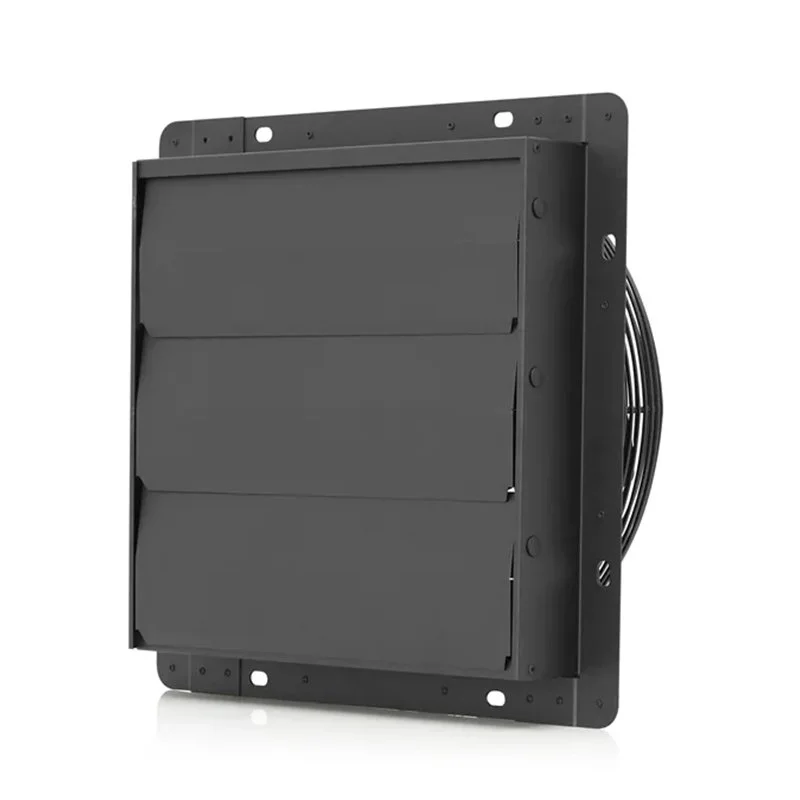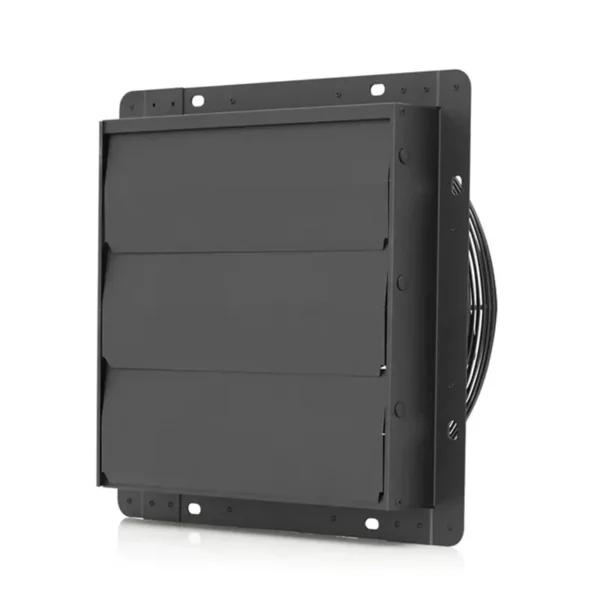
Shutter Exhaust Fan: The Ultimate Guide to Improved Ventilation
Introduction to Shutter Exhaust Fans
A shutter exhaust fan is an essential ventilation solution designed to remove stale air, odors, moisture, and heat from enclosed spaces while bringing in fresh air. These versatile fans feature adjustable shutters that automatically open when the fan operates and close when it’s off, preventing backdrafts and keeping pests out.
Whether you need to ventilate a kitchen, bathroom, workshop, warehouse, or commercial facility, understanding shutter exhaust fans can help you choose the perfect model for your needs while optimizing your space’s air quality and energy efficiency.
How Shutter Exhaust Fans Work
Shutter exhaust fans operate on a simple yet effective principle:
Fan Activation: When turned on, the fan’s motor begins spinning the blades
Shutter Mechanism: The airflow pressure automatically opens the louvers/shutters
Air Extraction: The fan pulls air from the interior space and expels it outside
Automatic Closure: When turned off, gravity or spring mechanisms close the shutters
This design provides several advantages over open-construction fans, including better weather protection, improved energy efficiency, and reduced pest intrusion.
Key Benefits of Shutter Exhaust Fans
1. Superior Ventilation Performance
Shutter exhaust fans provide powerful air movement, with industrial models capable of moving thousands of cubic feet per minute (CFM). This makes them ideal for spaces requiring significant air exchange.
2. Energy Efficiency
Modern shutter exhaust fans feature:
Energy-efficient motors
Adjustable speed controls
Thermostat integration
Humidity sensors
These features help reduce energy consumption while maintaining optimal ventilation.
3. Weather and Pest Protection
The automatic shutters:
Prevent rain and snow entry
Block wind-driven debris
Deter birds, insects, and rodents
Reduce drafts when the fan isn’t operating
4. Low Maintenance Design
Quality shutter exhaust fans are built with:
Rust-resistant materials (galvanized steel, aluminum, or PVC)
Easy-to-clean surfaces
Sealed bearings for long life
Simple louver mechanisms
Types of Shutter Exhaust Fans
1. Wall-Mounted Shutter Exhaust Fans
The most common configuration, designed for vertical installation through walls. Ideal for:
Kitchens
Bathrooms
Garages
Workshops
2. Roof-Mounted Shutter Exhaust Fans
Installed on rooftops for commercial or industrial applications:
Factories
Warehouses
Agricultural buildings
Commercial kitchens
3. Industrial Shutter Exhaust Fans
Heavy-duty models featuring:
Higher CFM ratings
More durable construction
Explosion-proof options for hazardous environments
4. Solar-Powered Shutter Exhaust Fans
Eco-friendly options that:
Reduce electricity costs
Operate independently of the power grid
Are perfect for remote locations
Choosing the Right Shutter Exhaust Fan
Consider these factors when selecting a shutter exhaust fan:
1. Size and Airflow Capacity
Calculate your space’s cubic footage (length × width × height)
Determine required air changes per hour (ACH)
Kitchen: 15-20 ACH
Bathroom: 8-10 ACH
Workshop: 6-8 ACH
Multiply cubic feet by ACH, then divide by 60 for CFM requirement
2. Material Considerations
Aluminum: Lightweight, rustproof, moderate cost
Galvanized steel: Durable, economical, heavier
Stainless steel: Premium corrosion resistance
Plastic/PVC: Lightweight, affordable, less durable
3. Motor Quality
Look for:
Thermally protected motors
Ball bearings (better than sleeve bearings)
UL-listed components
Appropriate voltage (120V residential, 208/240V commercial)
4. Noise Level
Measured in sones:
1-2 sones: Very quiet (bedrooms, offices)
3-4 sones: Moderate (most residential applications)
5+ sones: Industrial/commercial use
Installation Tips for Shutter Exhaust Fans
Proper installation ensures optimal performance:
Location Selection:
Place opposite from air intake sources
Avoid obstructions near intake and exhaust
Consider moisture sources in bathrooms/kitchens
Wall Preparation:
Cut opening slightly larger than fan housing
Install weatherproof flashing for exterior walls
Ensure proper support for heavy units
Electrical Connections:
Follow local electrical codes
Use GFCI protection in wet locations
Consider adding timer or humidity controls
Sealing and Insulation:
Apply weatherproof sealant around exterior
Insulate around interior housing in climate-controlled spaces
Maintenance and Care
Extend your shutter exhaust fan’s lifespan with regular maintenance:
Monthly Cleaning:
Wipe down shutters and housing
Vacuum fan blades (power off)
Check for debris buildup
Seasonal Inspection:
Test shutter operation
Lubricate moving parts if needed
Check electrical connections
Annual Deep Cleaning:
Remove fan assembly if possible
Clean motor housing vents
Inspect for corrosion
Troubleshooting Common Issues:
Shutters not opening: Check for obstructions, test spring mechanism
Reduced airflow: Clean blades, check duct obstructions
Unusual noises: Tighten loose parts, check bearing wear
Energy Efficiency and Smart Features
Modern shutter exhaust fans offer several efficiency enhancements:
Variable Speed Controls:
Adjust airflow as needed
Reduce noise during low-demand periods
Save energy
Automatic Controls:
Humidity sensors (ideal for bathrooms)
Thermostats (for temperature-controlled ventilation)
Motion sensors (for intermittent use spaces)
Smart Home Integration:
WiFi-enabled models
Voice control compatibility
Remote monitoring via apps
Heat Recovery Options:
Some models can transfer heat from exhausted air
Reduce heating costs in winter
Maintain better temperature balance
Applications for Shutter Exhaust Fans
Residential Uses:
Kitchens: Remove cooking odors, grease, and moisture
Bathrooms: Control humidity to prevent mold
Laundry Rooms: Vent moist air from dryers
Home Gyms: Maintain fresh air during workouts
Commercial/Industrial Uses:
Restaurant Kitchens: Meet health code requirements
Manufacturing Facilities: Remove fumes and heat
Agricultural Buildings: Control humidity for animal health
Parking Garages: Ventilate vehicle exhaust
Cost Considerations
Shutter exhaust fan prices vary based on:
Size: $50 (small residential) to $2,000+ (large industrial)
Materials: Plastic < Aluminum < Steel < Stainless
Features: Basic < Humidity-sensing < Smart-enabled
Installation: DIY vs. professional ($150-$500 labor)
Remember that energy-efficient models may qualify for utility rebates or tax credits.
Frequently Asked Questions
Q: How often should I run my shutter exhaust fan?
A: Run kitchen fans during and after cooking, bathroom fans during and 15-30 minutes after showering. Other spaces vary by use.
Q: Can shutter exhaust fans be used in winter?
A: Yes, but minimize use in very cold weather to prevent heat loss. Consider models with insulated shutters or heat recovery.
Q: What’s the lifespan of a quality shutter exhaust fan?
A: 10-15 years for residential models with proper maintenance, 5-10 for heavy industrial use.
Q: How do I know if my fan is sized properly?
A: It should completely exchange the air in your space within the recommended time (e.g., 8 minutes for a bathroom).
Q: Can I install a shutter exhaust fan myself?
A: DIY installation is possible for handy homeowners, but consult an electrician for wiring and always follow local codes.
Conclusion
A shutter exhaust fan is a smart investment for any space requiring effective, reliable ventilation. By understanding the different types, features, and proper installation techniques, you can select the perfect fan to improve your indoor air quality, control moisture, and maintain a comfortable environment. Whether for residential or commercial use, the right shutter exhaust fan will provide years of trouble-free operation when properly selected and maintained.

